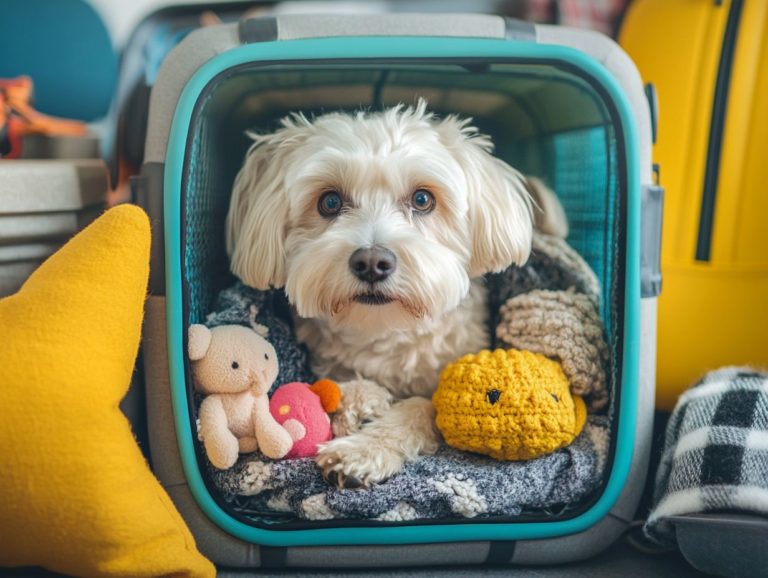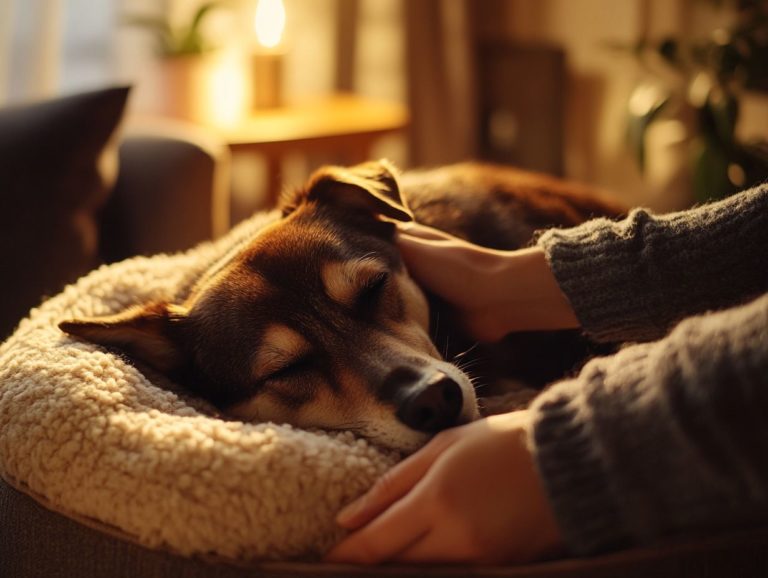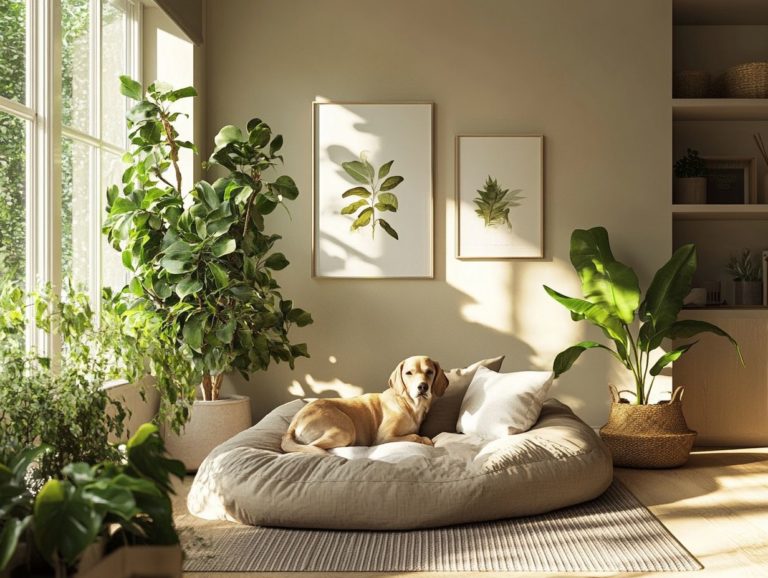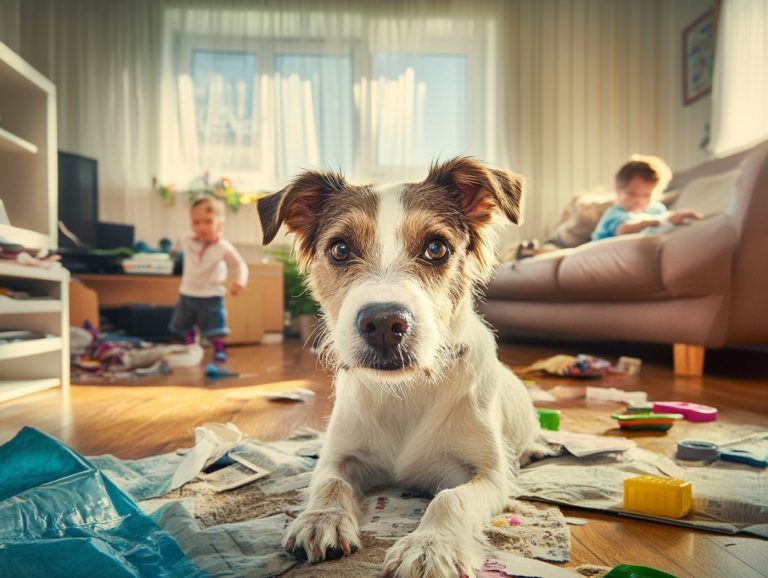5 Techniques for Calming Anxious Pets
Dealing with an anxious pet can be quite the challenge, often leaving you feeling overwhelmed and uncertain about how to provide the support they need.
Fortunately, there are effective techniques you can employ to create a calming environment and help address your furry friend’s anxiety. Let’s dive into simple yet effective strategies that can transform your pet’s anxiety into calmness. This article covers five practical strategies, from crafting a serene space to using calming tools and implementing behavioral training. It also highlights the importance of regular exercise and offers guidance on when it might be necessary to seek professional help.
Understanding your pet s anxiety is the crucial first step toward transforming them into a happier, more relaxed companion.
Contents
Key Takeaways:
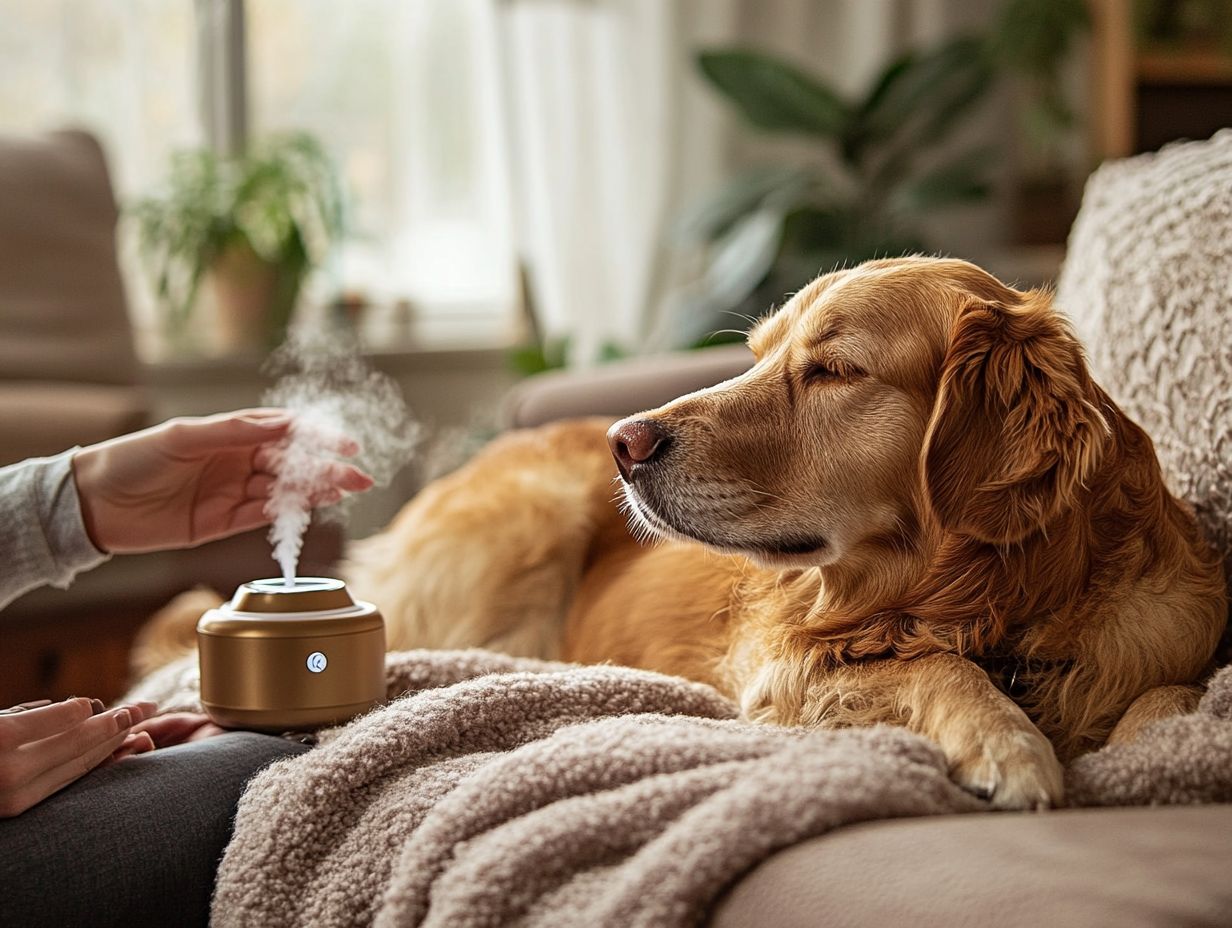
- Create a safe and calm environment for your pet to help reduce their anxiety levels.
- Consider using calming tools such as pheromone sprays or pressure vests to help soothe your pet’s nerves.
- Behavioral training techniques, such as desensitization (exposing your pet to anxiety triggers in a controlled way) and counterconditioning (associating triggers with positive experiences), can be effective in managing anxiety in pets.
1. Create a Safe and Calm Environment
Creating a safe and serene environment for your dog is essential in easing their anxiety. This secure space allows your pet to feel comfortable and protected from various anxiety triggers, significantly enhancing their mental well-being and behavior. Tailoring this environment to your dog’s unique needs is key, as it promotes relaxation and emotional stability while minimizing stress exposure.
To achieve this, think about incorporating quiet areas where your dog can retreat, like a cozy corner with their favorite blanket or bed. Familiar items, like toys or something carrying your scent, can offer a sense of comfort during stressful moments.
It s crucial to observe your dog’s cues and recognize signs of anxiety, such as pacing, excessive barking, or hiding, so you can respond appropriately. By offering emotional support gentle reassurance and a calming presence you can strengthen your bond and ensure your canine companion feels secure.
For additional strategies and expert advice tailored to your situation, the AKC GoodDog Helpline is an invaluable resource for concerned pet owners.
2. Use Calming Aids
Calming aids are essential for reducing anxiety in dogs, offering you a range of effective options. If you also have a cat, check out 5 tips for calming an anxious cat. Consider the Thundershirt, which applies gentle pressure to create a sense of security, or explore music therapy and pet-friendly diffusers that release soothing scents to help your pet feel more at ease in their surroundings.
These aids differ significantly in approach, from the comforting embrace of a snug vest to the harmonious sounds of playlists specifically designed to calm a restless mind. Music therapy, tailored for canine listeners, has proven remarkably effective in lowering stress levels, promoting tranquility through carefully selected frequencies and rhythms.
These auditory strategies, along with Bach flower remedies, offer a holistic solution, tapping into the power of natural essences to help dogs navigate their emotional landscape with greater ease. Incorporating pet supplements like calming chews or treats can further enhance these methods, providing an additional layer of support to manage pet anxiety and foster a serene environment for your furry companions.
3. Try Behavioral Training
Behavioral training is vital for addressing unwanted behaviors in anxious dogs. By employing methods like positive reinforcement and simple techniques, you can gradually build your pet’s confidence and self-control, ultimately transforming them into a more relaxed and well-adjusted companion.
For instance, when you use positive reinforcement, rewarding your dog with treats or praise for calm behavior during stressful situations helps them associate those moments with something enjoyable. Desensitization involves exposing your dog to anxiety-inducing triggers at a controlled level, all while pairing these experiences with positive outcomes.
It’s essential to keep in mind that this process isn’t instantaneous. Consistency in your training sessions, coupled with a generous dose of patience, is crucial. Over time, this approach can significantly diminish anxiety triggers, enabling your dog to develop effective coping mechanisms and thrive in various environments.
Don’t wait—your pet deserves a peaceful environment now! Implement desensitization techniques for anxious pets today and watch your furry friend become more relaxed and happy.
4. Provide Adequate Exercise and Mental Stimulation
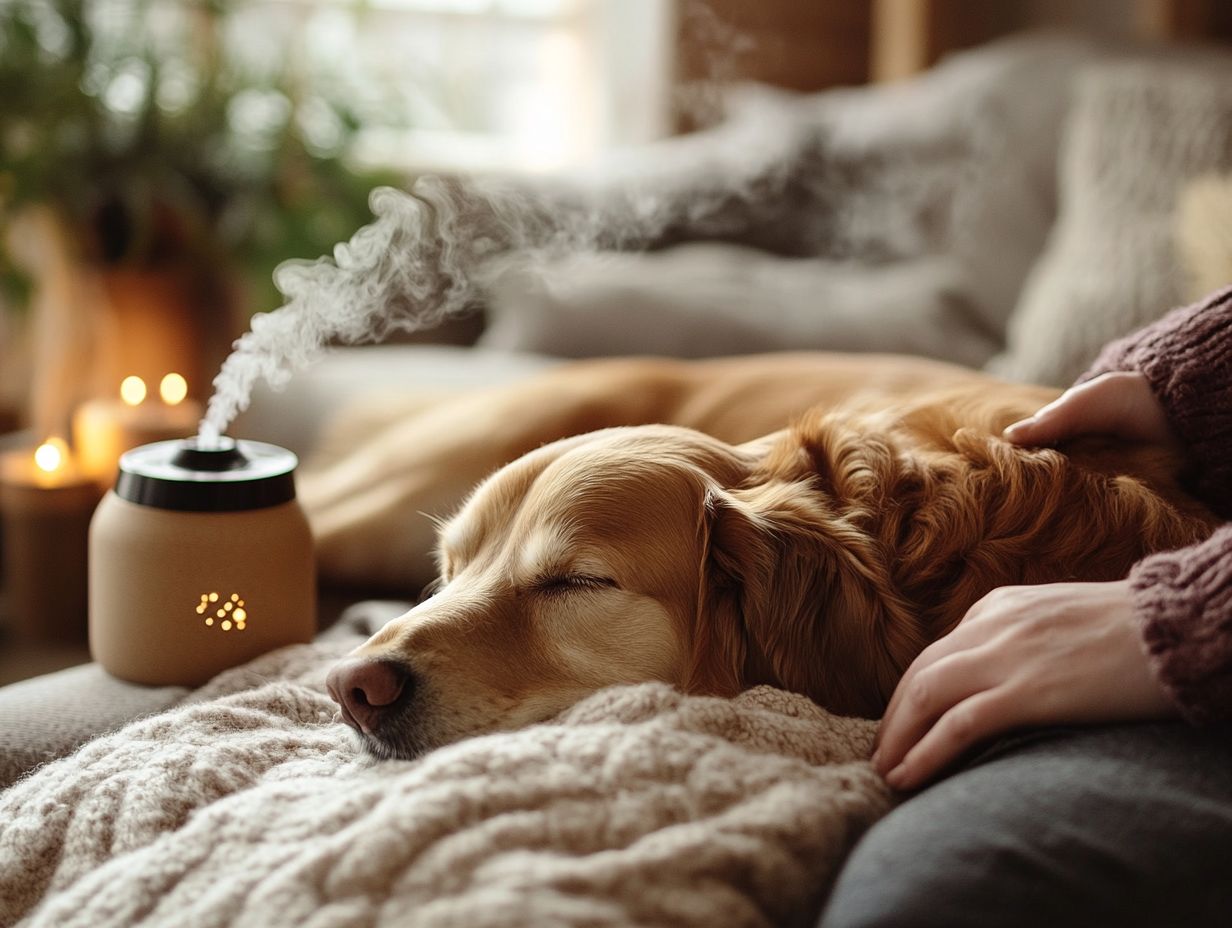
Adequate exercise and mental stimulation are essential for managing anxiety in your dog. Engaging activities like interactive toys, calming games, and dog sports can help channel your pet’s energy productively.
These activities reduce anxious behaviors and promote a healthier mindset. Regular exercise is crucial for your dog s well-being.
Different breeds and temperaments respond uniquely to specific types of stimulation, so tailoring activities to fit your dog is crucial. For energetic breeds like Border Collies or Labrador Retrievers, consider structured walks, agility training, or fetch games that challenge both their physical and mental faculties.
On the flip side, more relaxed breeds, such as Bulldogs or Shih Tzus, may thrive on leisurely strolls paired with puzzle feeders that engage their minds without overwhelming their bodies.
Incorporating short training sessions throughout the day not only reinforces good behavior but also enriches their mental landscape. This balanced approach helps mitigate anxiety and strengthens the bond between you and your dog, creating a harmonious living environment.
Utilizing relaxation techniques and physical contact can further enhance this process.
5. Seek Professional Help
If home remedies aren t working for your dog s anxiety, it s time to reach out for professional help. A veterinarian or the AKC GoodDog Helpline can provide tailored solutions just for your pet.
Consulting with specialists is essential because they bring the knowledge and experience necessary to identify underlying causes of anxiety that you might overlook. They can conduct a thorough assessment of your dog’s behavior and recommend effective anxiety treatment plans tailored specifically to their needs.
During these consultations, be prepared to discuss your dog’s daily routines, triggers, and symptoms. You might also discover a wealth of resources at your disposal, such as veterinary behaviorists or specialized training programs. Taking advantage of these resources will not only help manage your dog’s anxiety but will also nurture a healthier relationship between you and your canine companion.
What Causes Anxiety in Pets?
Understanding the causes of anxiety in your pets is essential for effective management and treatment. Various factors, such as separation anxiety, specific fears, and unique anxiety triggers, can significantly impact your dog s emotional well-being. This can lead to behaviors that require careful handling and, at times, appropriate protective gear or natural remedies to provide relief.
Common triggers include loud noises like thunderstorms or fireworks, which can cause your dog to react frantically. Environmental changes such as moving to a new home or welcoming new family members can also spark anxiety responses, especially in anxious dogs.
To identify these triggers, observe any behavioral changes in your dog, such as pacing, excessive barking, or hiding. Make a note of situations that provoke stress, as early intervention is crucial.
By addressing anxiety symptoms promptly, you not only cultivate a more relaxed pet but also prevent these behaviors from escalating. This ultimately fosters a more harmonious living environment for both you and your furry companion. For additional strategies, consider 5 ways to improve your anxious pet’s quality of life, and implementing massage therapy and other calming techniques can also help.
How Can You Tell If Your Pet Is Anxious?
Recognizing the signs of anxiety in your pet quickly is essential to help them feel safe again. Behaviors such as excessive barking, pacing, hiding, and destructive actions can signal underlying anxiety. Understanding your dog s emotional state can guide you in improving their self-control.
It’s also important to pay attention to subtle cues, like changes in body language think tucked tails or flattened ears that may indicate discomfort. If your dog suddenly becomes restless or overly clingy, it could be a sign of heightened stress levels.
By observing these signs closely, you can better interpret your pet’s emotions, leading to more effective management strategies. Regularly assess your environment for potential triggers, such as loud noises or unfamiliar visitors. Making necessary adjustments can create a safer space, fostering a more serene atmosphere for your anxious dog.
What Are the Different Types of Calming Aids for Pets?
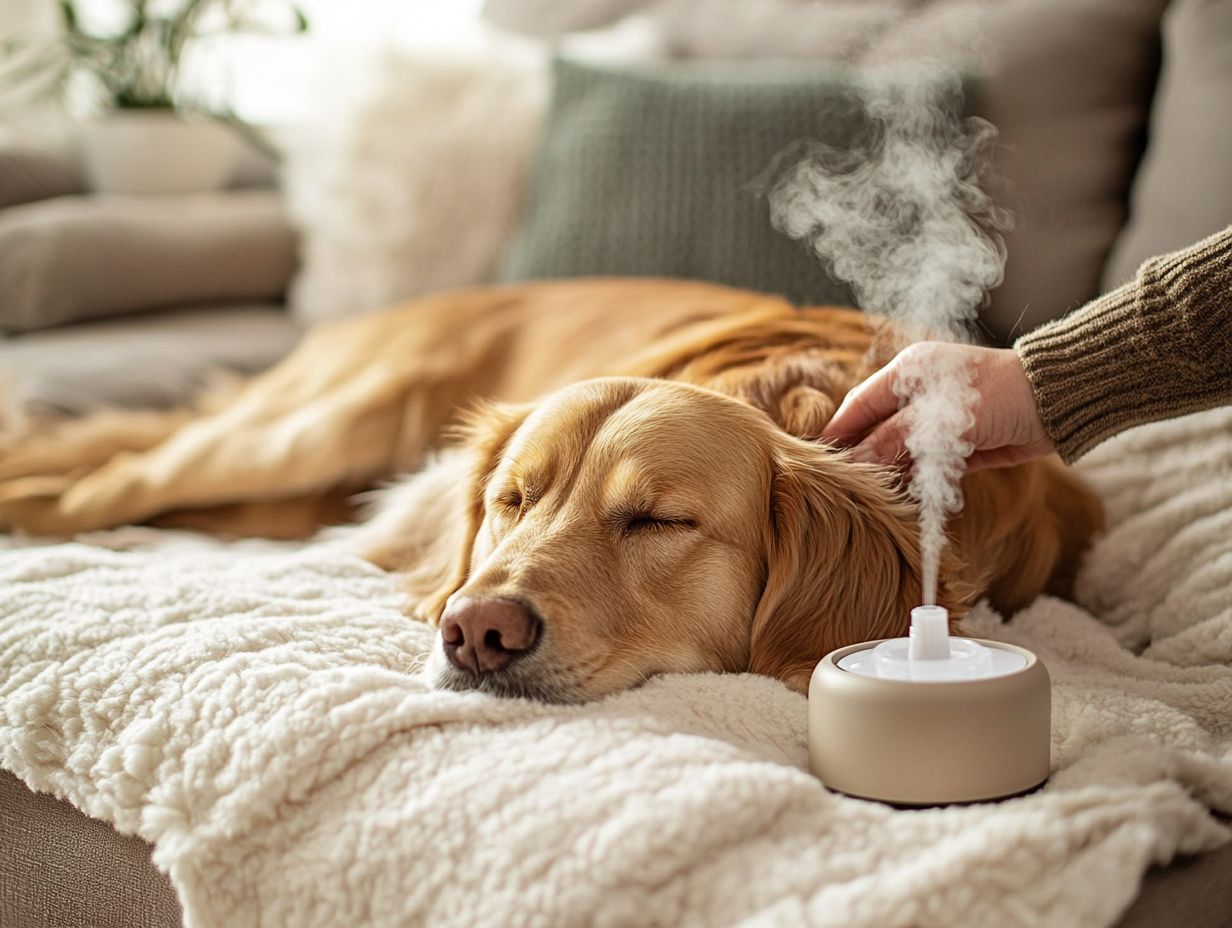
You have a variety of calming aids for your pets. These include the Thundershirt, which provides gentle pressure, music therapy to ease anxiety, pet-friendly diffusers that release soothing scents, and calming coats. Each of these is designed to create a serene environment for your anxious dog. Additionally, you might find top training techniques to reduce pet anxiety helpful. You might also consider Rescue Remedy as a natural option.
Each of these aids plays a specific role in tackling various anxiety triggers. For example, the Thundershirt applies consistent, gentle pressure, making your dog feel more secure during thunderstorms or fireworks. Additionally, creating a calm environment for anxious pets can include soothing music or sounds tailored for pet relaxation to help divert your dog’s attention from stressful stimuli. Diffusers that emit essential oils like lavender or chamomile can transform the atmosphere into one of tranquility.
Using these aids together often leads to even better outcomes. Imagine pairing the calming scent of a diffuser with the snug embrace of a Thundershirt; this multi-layered approach can significantly reduce anxiety, resulting in a more peaceful and content pet.
What Are Some Behavioral Training Techniques for Anxious Pets?
Behavioral training techniques, such as positive reinforcement and desensitization, can greatly enhance the well-being of anxious pets. Implementing techniques to calm anxious pets before training helps them cope with their anxiety triggers while fostering a learning environment.
Incorporating these strategies into your training sessions can cultivate a more confident and secure atmosphere for your dog. For instance, when your dog remains calm near loud noises, rewarding that behavior reinforces a positive association with those sounds, ultimately reducing their fear.
You can also practice getting your dog used to things that scare them, like strangers or other dogs, in controlled settings. This gradual exposure allows them to adapt at their own pace.
These techniques not only improve your pet s behavior but also make your bond even stronger!
How Can Exercise and Mental Stimulation Help Calm Anxious Pets?
Exercise and mental stimulation are essential for calming anxious pets. Incorporating 5 tricks to calm pets during loud events can complement regular physical activity and engaging games with interactive toys, significantly reducing stress and fostering a more balanced dog.
Activities like fetch or agility training provide physical exertion and mental challenges, encouraging your dog to tap into their instincts and intelligence. Puzzle toys that dispense treats keep them entertained while enhancing their problem-solving skills.
Establishing routines that include daily walks or playtime not only keeps your dog active but also creates a predictable environment, boosting their sense of security.
Dogs thrive on structure. When they know what to expect, their anxiety diminishes considerably. These practices are vital for nurturing their overall well-being, ensuring they lead happy, content lives.
When Is It Time to Seek Professional Help for Your Anxious Pet?
Knowing when to seek professional help for your anxious pet is crucial, especially when home remedies don t seem to do the trick.
Persistent anxiety might call for specialized treatment from experts like the AKC GoodDog Helpline or your veterinarian.
Watch for signs that your pet needs help! If you notice behaviors like excessive barking, hiding, or destructive chewing becoming the norm, it may be time to acknowledge that self-managed strategies just aren t cutting it.
If your daily routine feels disrupted, it may be time to act. Struggling with walks or social interactions are signs that help might be necessary.
Addressing these concerns quickly can improve your pet s quality of life and well-being. Recognizing the importance of timely action is vital; taking steps sooner rather than later can greatly benefit your furry friend.
Frequently Asked Questions
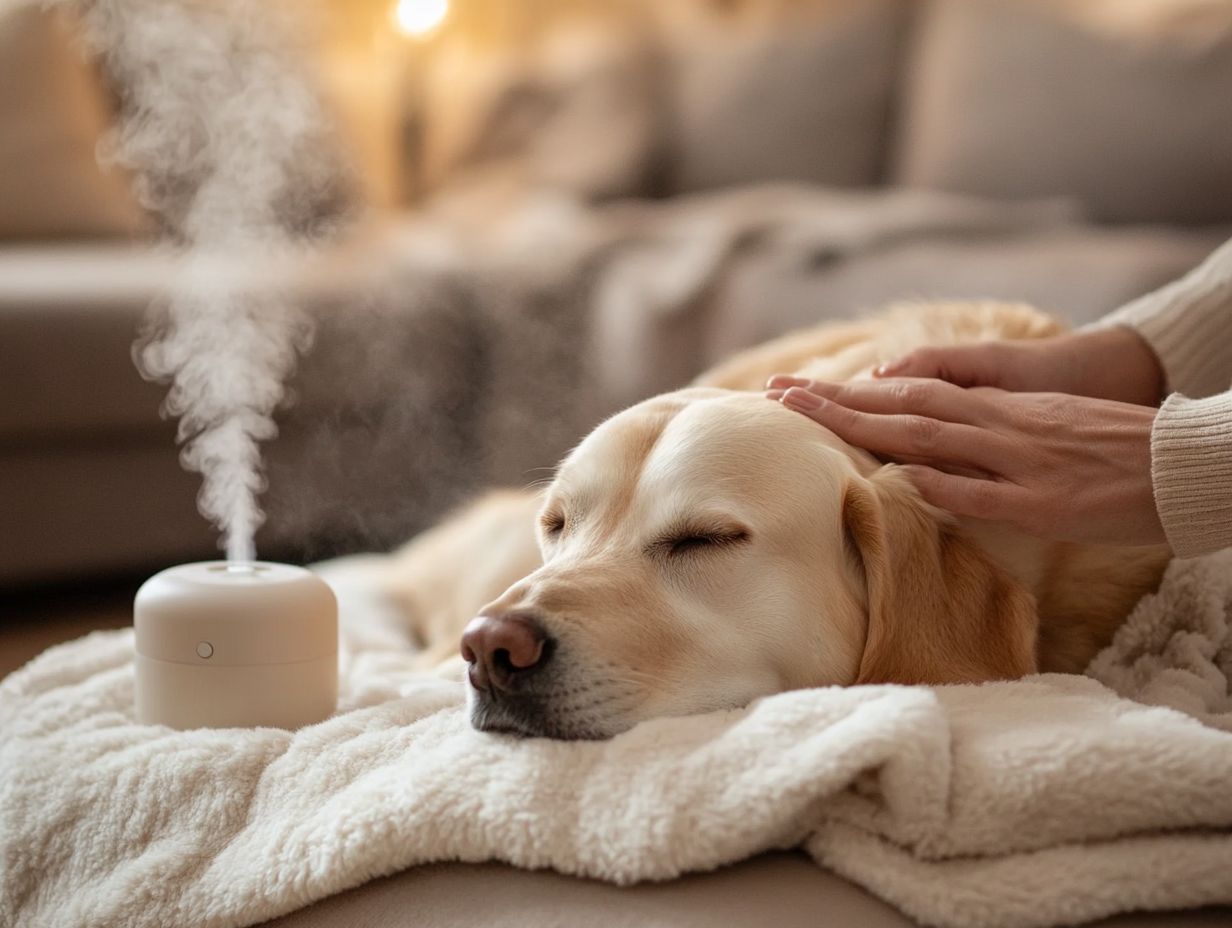
What are some techniques for calming anxious pets?
- Exercise: Regular exercise can help reduce your pet’s anxiety levels and promote a sense of calm. Take your pet for walks or engage them in playtime to release pent-up energy.
- Massage therapy: Just like humans, pets can benefit from a calming and relaxing massage. Use gentle strokes and pressure to help alleviate stress and tension.
- Music therapy: Certain types of music, such as classical or soft instrumental, can have a calming effect on pets. Play soothing music in the background to create a peaceful environment.
- Petting and cuddling: Physical touch and affection can go a long way in calming an anxious pet. Spend quality time with your pet by petting, cuddling, or simply sitting next to them.
- Aromatherapy: Essential oils like lavender and chamomile can have a calming effect on pets. Use a diffuser or spray diluted essential oils in the air to help your pet relax.
How does exercise help calm anxious pets?
Regular exercise helps release endorphins in pets, reducing stress and anxiety levels. It also provides an outlet for excess energy, promoting a sense of calm and relaxation.
What type of massage is best for anxious pets?
A gentle and slow massage is best for anxious pets. Use long, smooth strokes and apply gentle pressure to help release tension and promote relaxation.
What kind of music can help calm anxious pets?
Soft instrumental or classical music can have a calming effect on pets. Avoid playing loud or high-pitched music, as it may have the opposite effect and increase anxiety levels.
Is petting and cuddling effective in calming anxious pets?
Yes! Physical touch and affection can help alleviate stress and anxiety in pets. Spend quality time with your pet by petting, cuddling, or simply being close to them.
How do essential oils help calm anxious pets?
Certain essential oils, like lavender and chamomile, have a calming effect on pets. To enhance your pet’s comfort, consider using a diffuser or diluted sprays in the air, along with essential training tools for anxious pets to create a soothing environment.
If you notice any of these signs, reach out to a professional today!

